Understanding football formations is key to grasping the strategies behind a team’s playstyle, and the 1-3-4-3 is one of the most intriguing setups in modern football. In this article, we’ll break down the 1-3-4-3 formation, exploring its structure, strengths, and how to use it to create both defensive stability and attacking opportunities. Whether you’re a player, coach, or fan, this guide will help you appreciate the tactical depth behind the 1-3-4-3 formation and how it can shape the outcome of a match.
Build-up
Building up in a 1-3-4-3 formation focuses on creating numerical superiority in the midfield while maintaining width through the wingbacks. The three center-backs provide a solid defensive base, with the central center-back often stepping into midfield to support build-up play. The two wide center-backs spread out to stretch the opposition’s press, creating space for the wingbacks to push up and occupy the flanks. In midfield, the double pivot provides passing options and ensures control in the center, while the front three stay high and centrally, ready to exploit any gaps in the opposition’s defense. This setup allows for fluid ball progression, quick transitions, and the ability to shift play across the pitch, making it difficult for the opposition to predict and intercept passes.
Low Build-up
The 1-3-4-3 formation offers much flexibility in the low build-up. The goalkeeper can move up into the backline to create a back four, allowing the wingbacks to push higher. This puts the team in a 4-2-5 formation, where the six building players can work together to beat the initial press and the five attackers can cooperate to create goalscoring opportunities
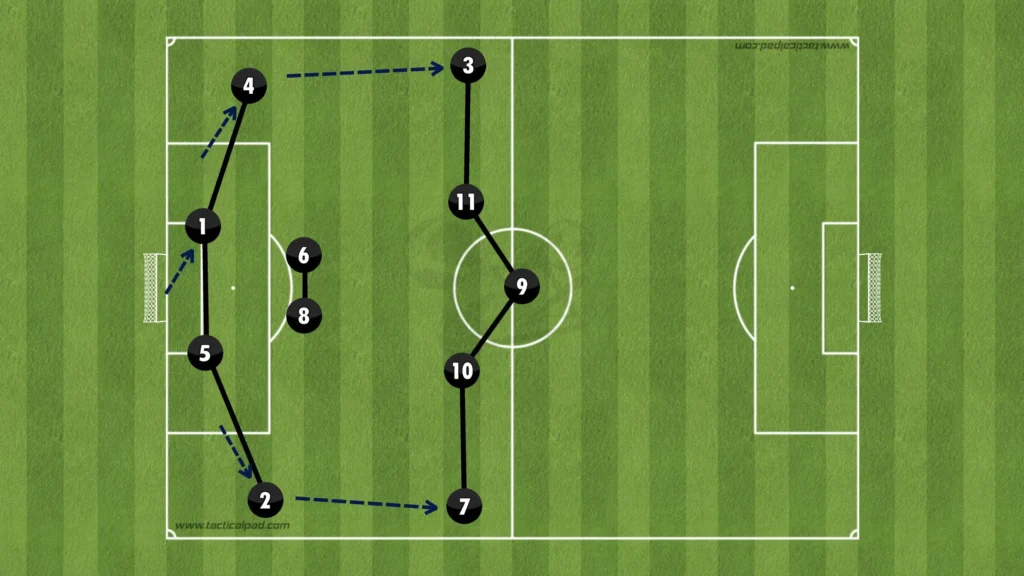
Low build-up while -1 in the forward line
When the opposition comes up to press with four players, they will be +1 in the backline against the five attackers. This means there will be a 6v4 numerical advantage lower down the pitch for the attacking team. This 6v4 can exploited in different ways, depending on how these four players press together. Regardless of how they press, the attacking team should be able to beat these players, allowing them to progress the ball up the pitch.
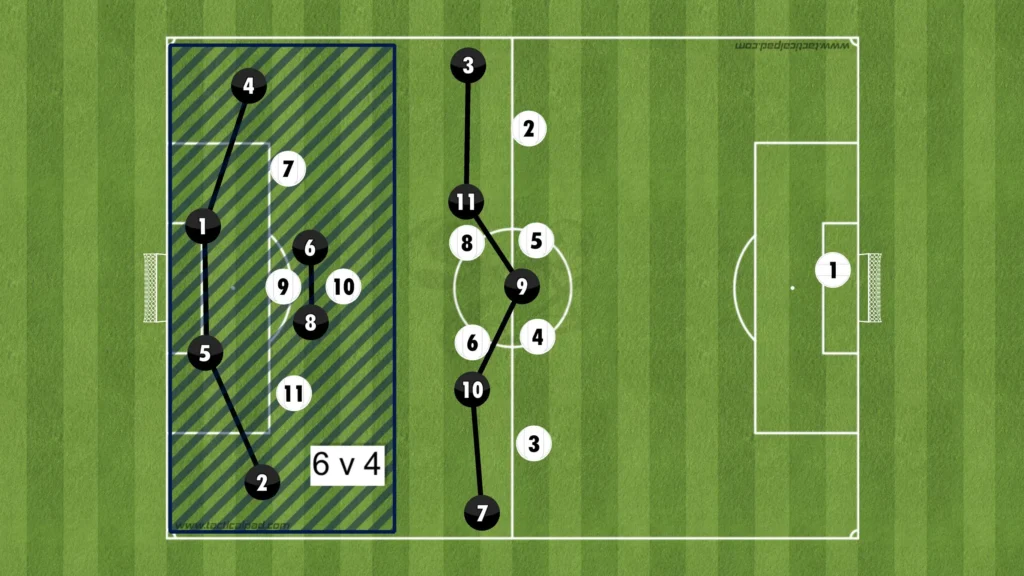
Low build-up vs man-to-man system (numerical equality)
If the opposition comes up and presses man-to-man, there will be numerical equality all over the pitch. The only place where a numerical advantage could be made is in your own penalty area with the goalkeeper and center-backs against the opposition strikers.
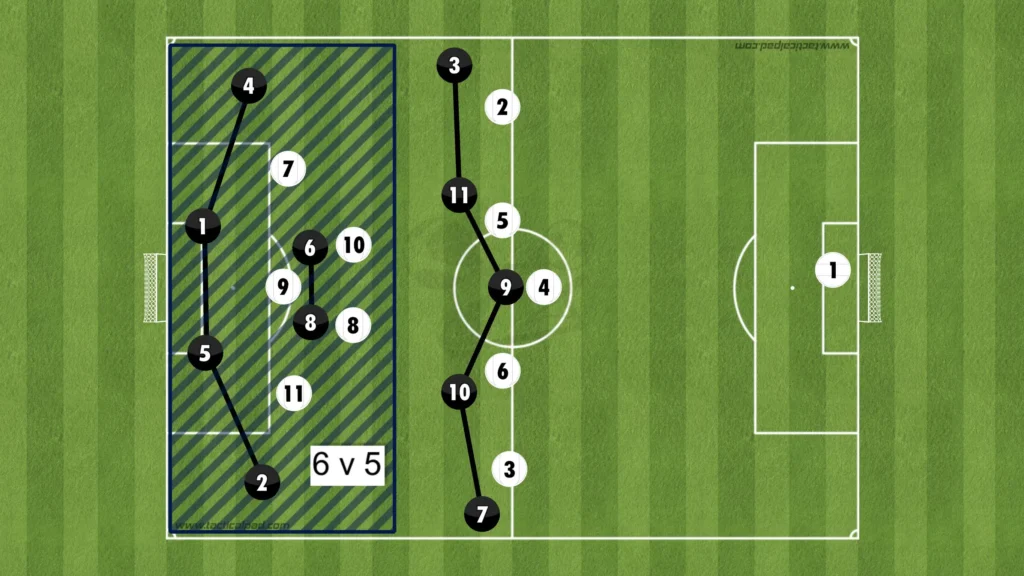
This 6v5 can be exploited to find a free center-back who can take the ball forward. A wide center-back will be open if the goalkeeper and central center-back can attract pressure from the opposition striker and one of the wingers. The ball could be played to the open center-back, who can take the ball forward and attract the press from a new opponent, which opens the space for a teammate.
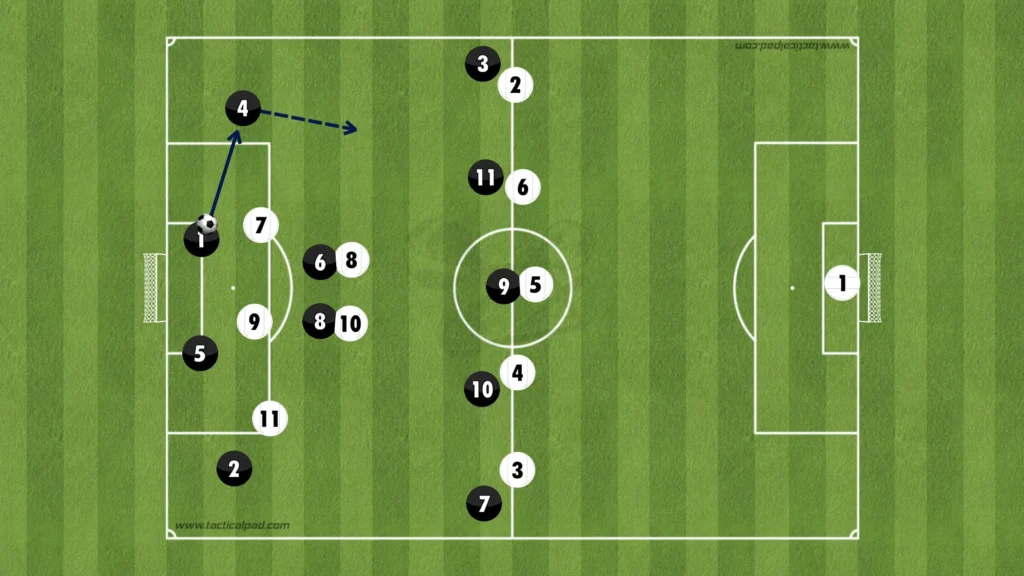
Building up like this is great in theory but requires massive concentration, training, and technique. One bad pass or bad touch will lead to a certain goal. To avoid that risk, many teams go long when building up against a man-to-man system. In the 4-2-5 formation, there will be a 5v5 high up the pitch to compete for a long ball. The attackers can work together to win the first and second balls by getting around their opponents and anticipating where the ball will land.
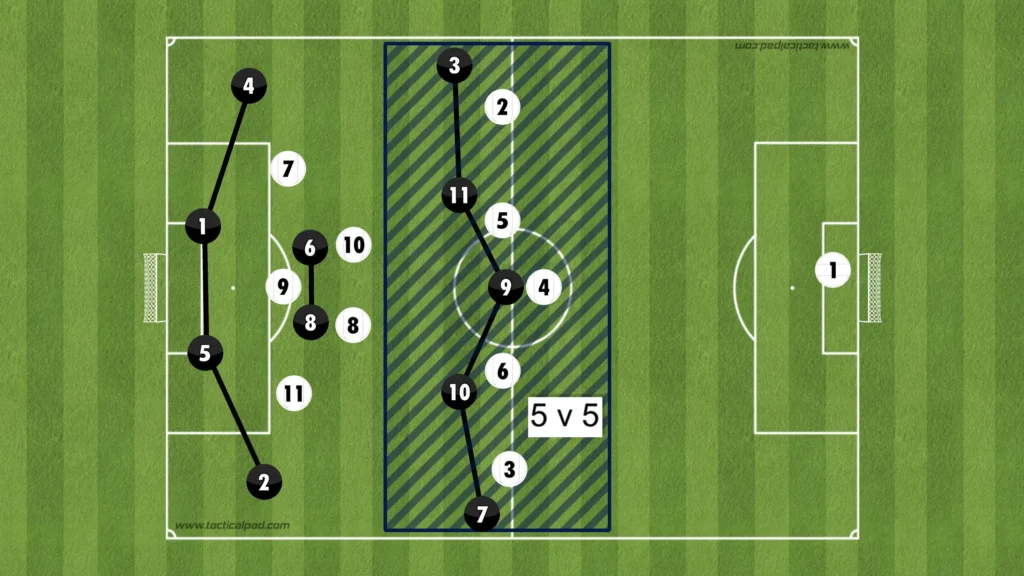
High Build-up
The 1-3-4-3 formation, which often turns into a 1-3-2-5 formation, can be used in many different ways in the high build-up. One of the holding midfielders can drop into the backline, creating a back four. The wingbacks play a crucial role, providing either high or low width in attack. The attacking midfielders can drop down next to the holding midfielders or make runs in behind. The striker could also make runs in behind or drop into the midfield to create overloads.
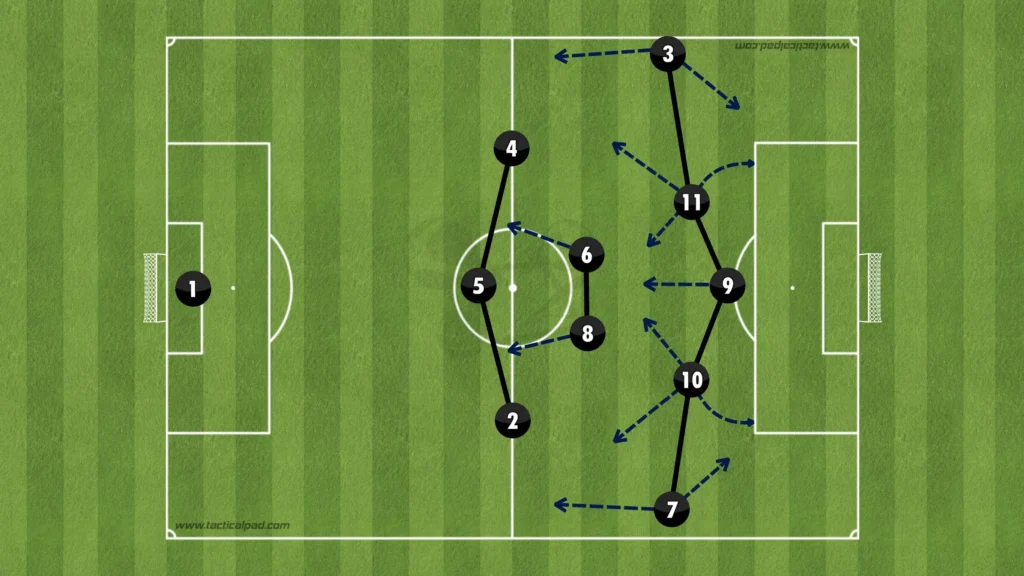
Staggered holding midfield
In a 1-3-4-3 formation, positioning the holding midfielders on different lines during the build-up is crucial for creating passing lanes and disrupting the opposition’s defensive structure.
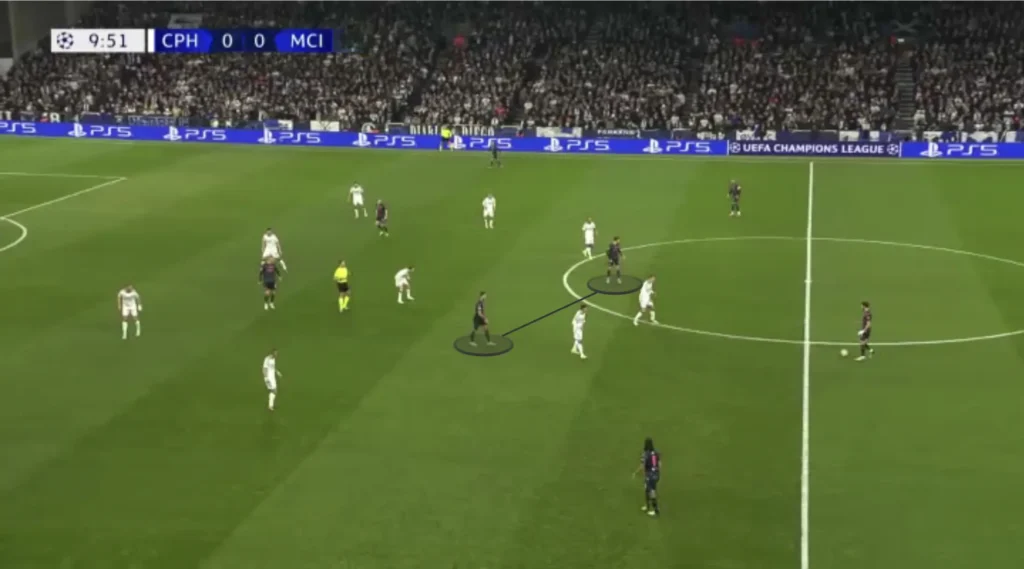
When the holding midfielders are staggered—one slightly ahead of the other—it forces the opposition’s attackers to make difficult decisions on who to block off, opening up space for the team to advance the ball. This layered positioning also enhances ball circulation by providing multiple angles for passing, reducing the risk of predictable or intercepted passes. The holding midfielders can play between themselves, allowing them to find third-man combinations to beat the opposition’s first line of pressure.
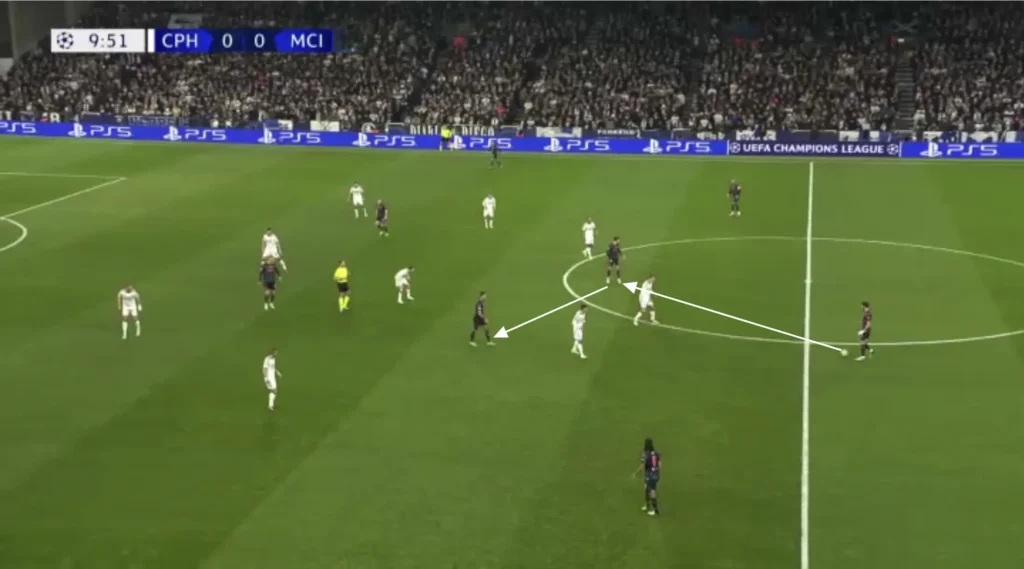
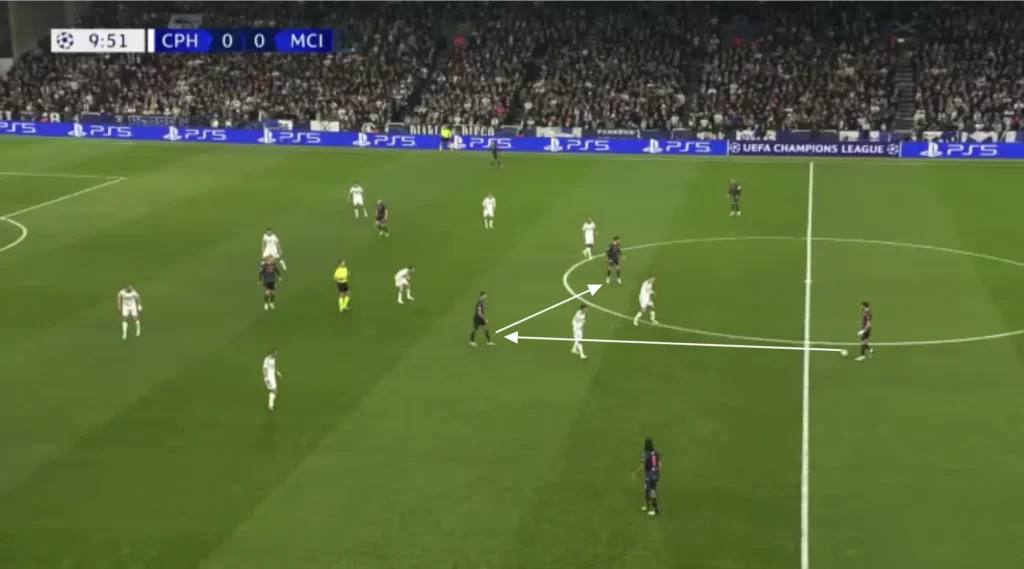
Additionally, by occupying different vertical spaces, the midfielders can better support both the defense and the attack, ensuring smoother transitions and greater control over the tempo of the game.
Numerical Advantage in the midfield
Having only the two wingbacks out wide and the rest of the players in the middle creates more options in the center and less space between the players. With two pivots and two number-tens moving around, you will almost always have a numerical advantage in the midfield. This means at least one midfielder will always be open. Therefore, 1-3-4-3 playing teams should prioritize playing through the middle. You will have one player out wide to pull the opposition apart while the rest create numerical advantages in the midfield areas.
Here is a situation where Spalletti’s Italy, who played in a 1-3-4-3 formation, used the numerical superiority in the midfield to beat Spain’s 1-4-2-3-1 defending. The Spanish central midfielder is in a 1v2 situation against Italy’s holding midfielder and attacking midfielder.
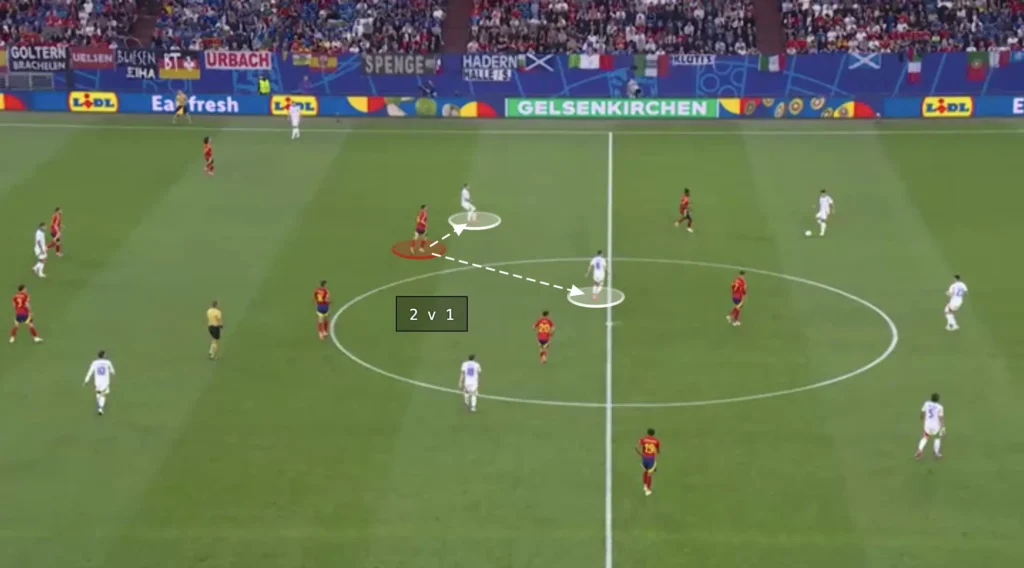
If he pushes up on the holding midfielder, the ball can be played to the attacking midfielder, using a simple third-man combination.
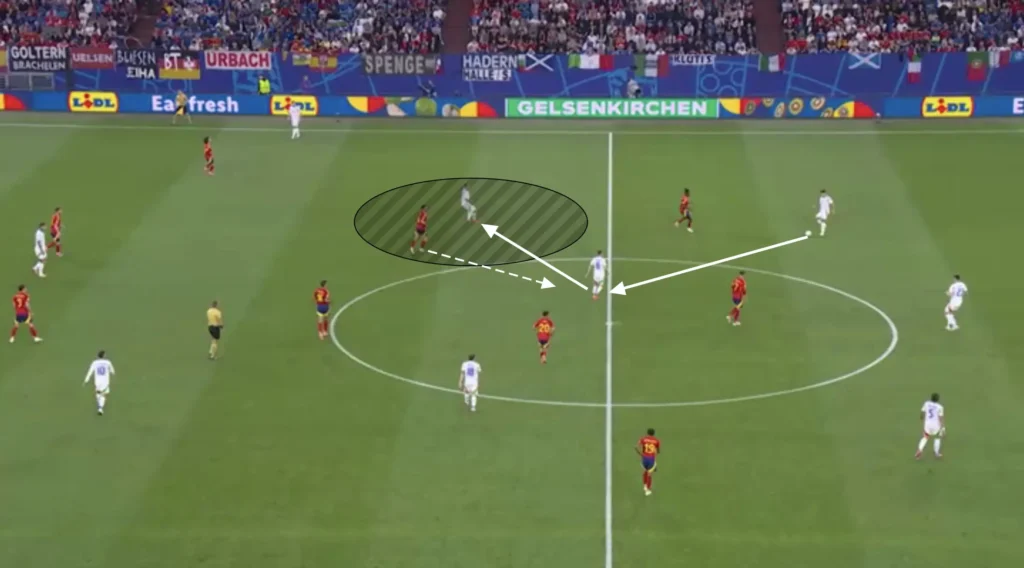
However, if he covers the attacking midfielder, the holding midfielder will have the time and space to receive the ball, turn, and take it up the pitch.
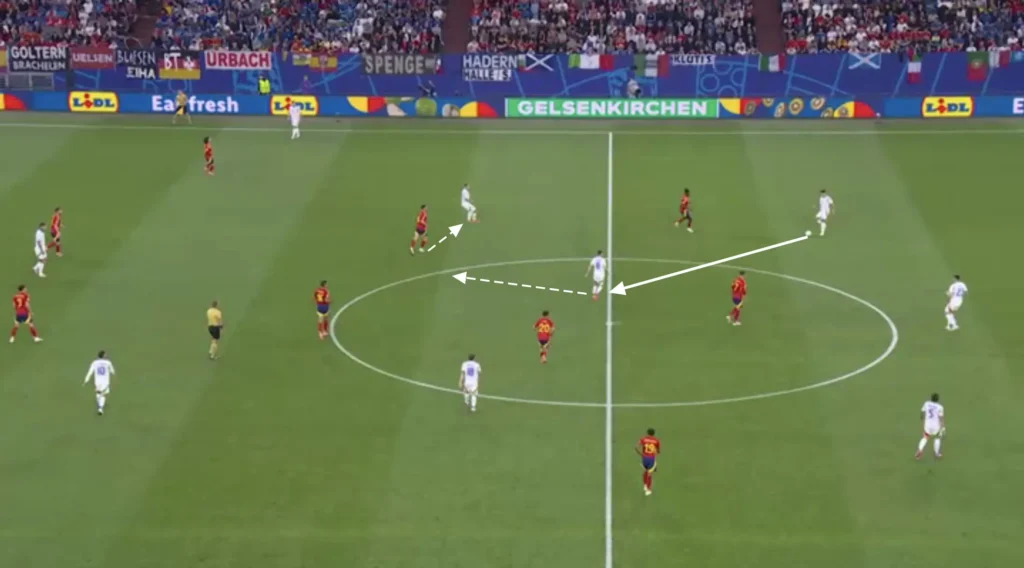
The Spanish midfielder chose to cover the Italian attacking midfielder in this situation, allowing the holding midfielder to turn and play a through-ball in behind the high Spanish backline.
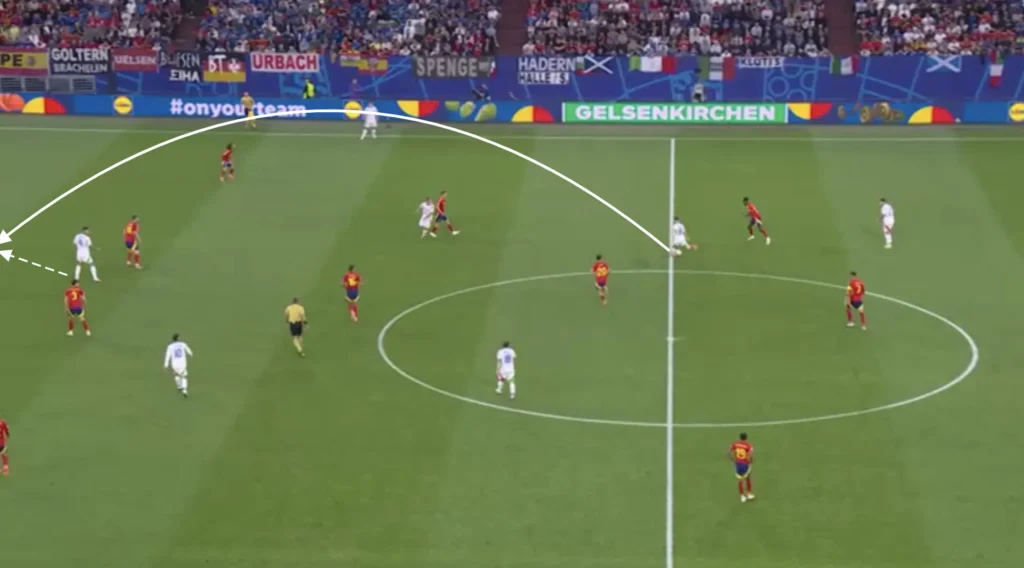
Rest-Defence
Rest-defence in the 1-3-2-5 formation is crucial for maintaining balance and preventing counterattacks when the team is in possession. Having many players in the middle builds good conditions in defensive transitions, allowing more players to counterpress when losing the ball. The three center-backs and two holding midfielders form the core of the rest-defence, as they are well-positioned to deal with any potential loss of the ball. When losing possession, the four or five players closest should immediately jump on the opposition player with the ball and close the distance to cut off any passing lanes. This approach disrupts the opponent’s transition from defense to attack, forcing errors and creating opportunities to regain control of the ball.
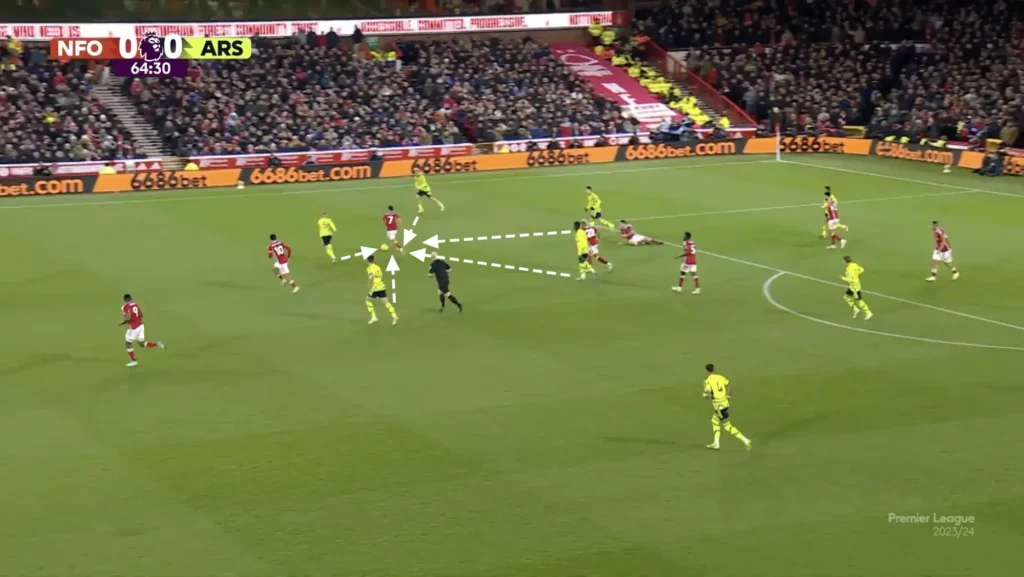
Additionally, when the opposition beats the initial counterpress, there will still be three defenders who can defend against the counterattack. Defending against counterattacks is often easier with a back three because the formation naturally provides more coverage across the width of the pitch. This setup allows one center-back to step forward to challenge the ball carrier, while the other two can provide support or cover the space behind. This added layer of security makes a back three particularly effective in mitigating the dangers of fast transitions from the opposition.
Finding the Pockets
In a 1-3-4-3 formation, the players should always try to find the attacking midfielders in the pockets. These “pockets” refer to the spaces between the opposition’s defensive and midfield lines, where the attacking midfielders can receive the ball in more advanced positions. By positioning themselves intelligently in these pockets, the attacking midfielders can turn quickly and face the opposition’s goal, creating opportunities for through balls, driving runs, or direct shots. This positioning forces the opposition to make difficult decisions. If an opposition defender steps up and closes down the attacking midfielder, he potentially leaves space behind. If he stays back, he allows the midfielder time on the ball. The defenders can look for straight passes, breaking the opposition lines and finding the attacking midfielders who can turn and drive at the defense.
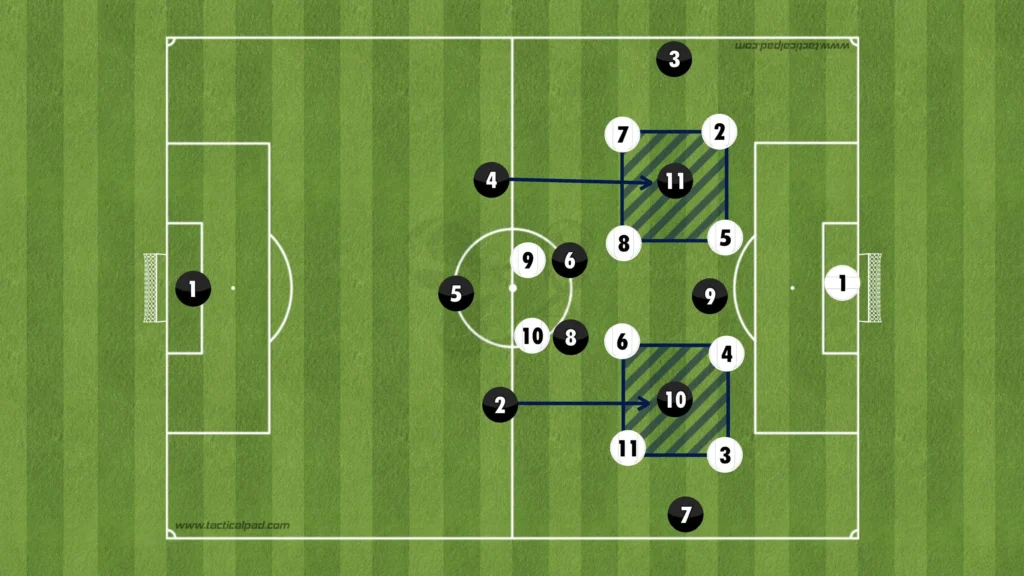
Finding these pockets is crucial for maintaining fluidity in attack and ensuring that the team can progress the ball effectively through the middle of the pitch.
Dropping Outside
When the opposition defends very compactly and does not allow the attacking midfielders to get the ball in the pockets, the attacking midfielders can drop outside to receive the ball there instead. They should wait for the opposition’s wide midfielders to press the wide center-backs and drop out into the space he left open. The opposition center-backs and central midfielders rarely follow these runs, not wanting to open the space in the center. Additionally, the winger, who is positioned high and wide, will be pinning the opposition fullback, not allowing him to jump on the dropping attacking midfielder. This means that the attacking midfielder can receive the ball, turn, and progress the ball unopposed.
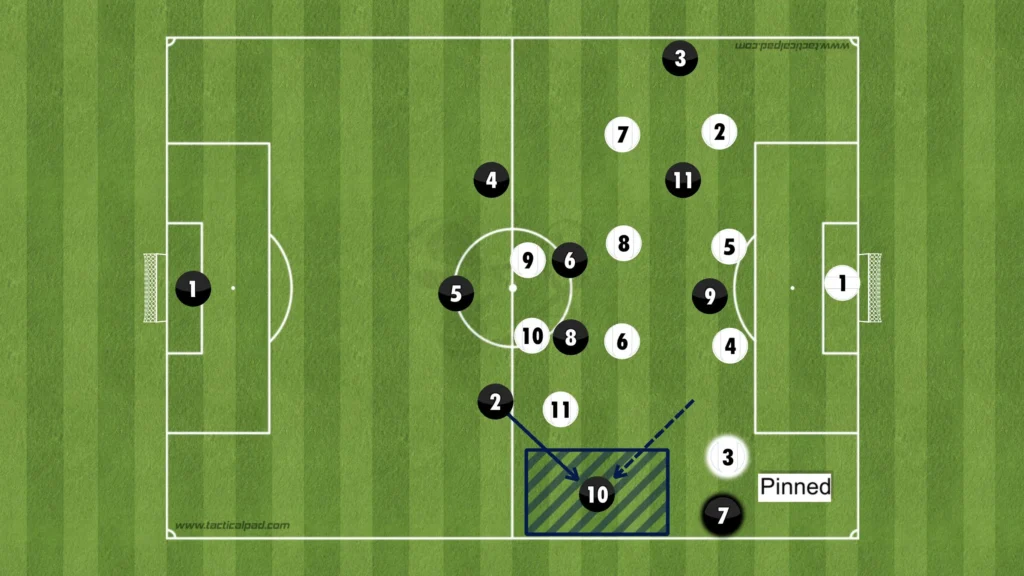
Numerical Advantage Against the Opposition Backline
Another massive aspect of building up in a 1-3-2-5 formation is creating numerical advantages against the opposition’s defensive line. The front five naturally becomes numerically superior against a back four, which should be taken advantage of.
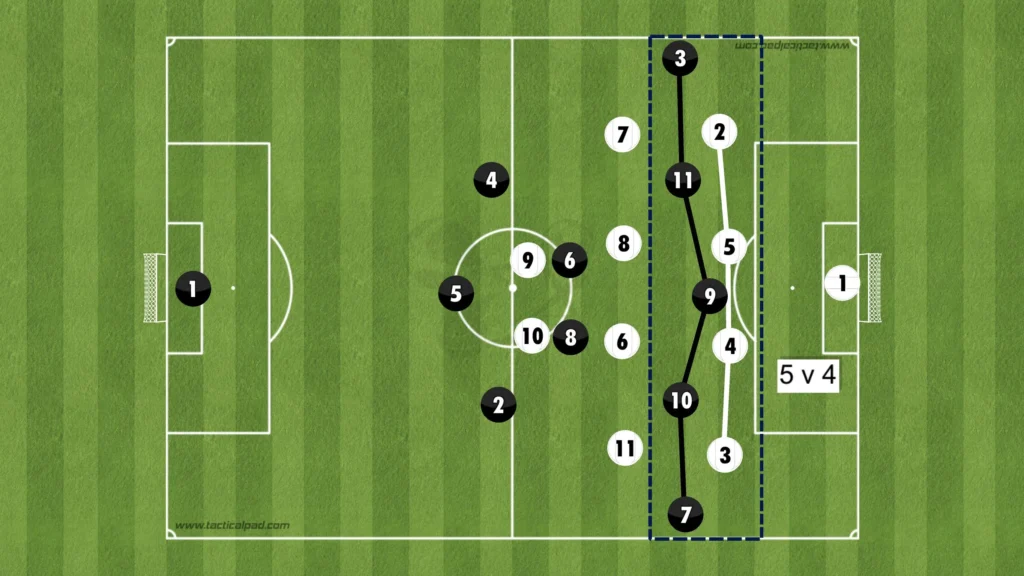
The most common way to exploit this is to create 2v1 situations against the opposition fullback. When the defending team is positioned on one side, the opposition’s far-side fullback becomes vulnerable to the long switch of play due to the 1v2 against the winger/wingback and attacking midfielder.
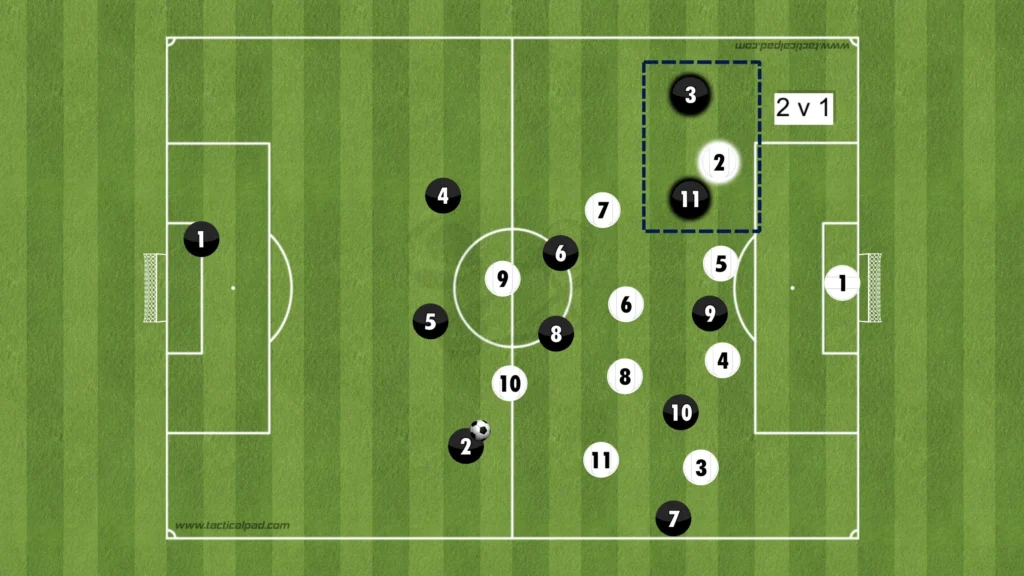
If the attacking midfielder makes a run in behind and the fullback follows that run, the space for the winger out wide will open. A midfielder or defender can play the long switch to the winger, who will have the time and space to get control of the ball. This is an easy way to get the ball to the winger in advanced positions and often creates 2v1 situations on the wing and in the half-spaces.
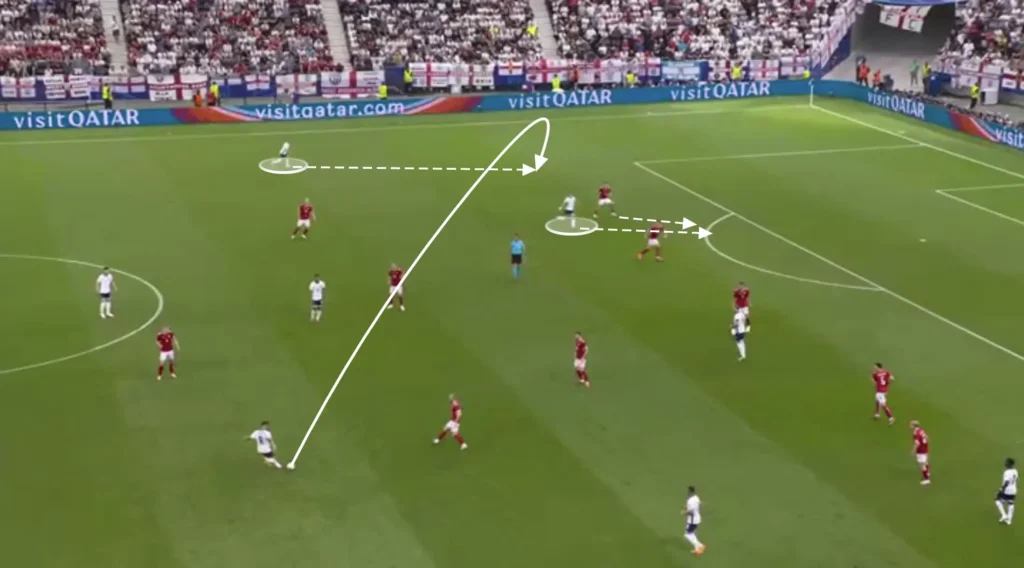
Counter-Movements
You could also use counter-movements between the winger and attacking midfielder to exploit this numerical advantage. When a wide center-back has the ball, the attacking midfielder can make a run in behind while the winger drops to open the passing lane from the wide center-back.
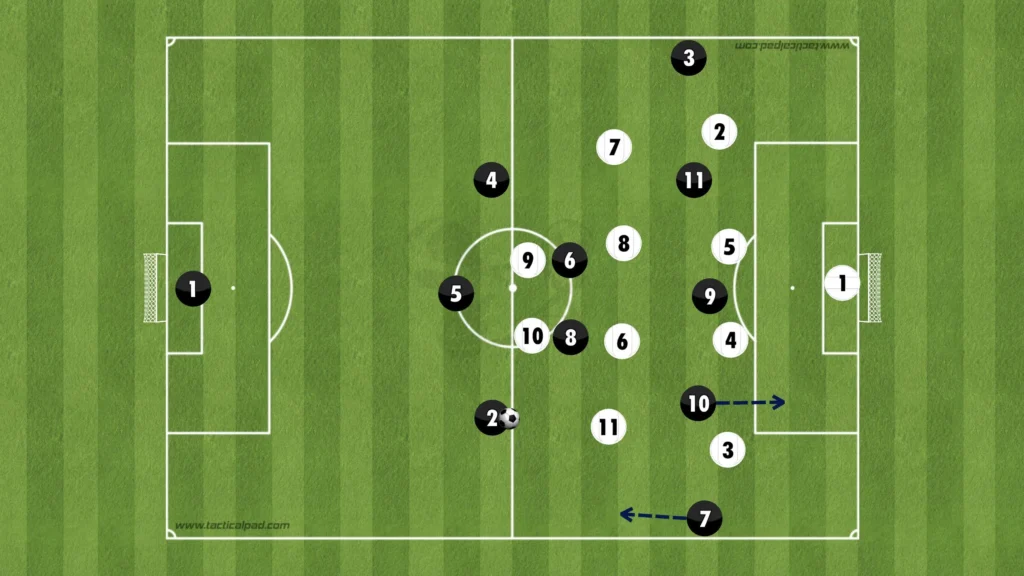
This creates a question for the opposition fullback. If he steps out on the winger, the space behind him opens up, allowing the center-back to play a through-ball to the attacking midfielder. However, if he stays inside to cover the run, the ball can be played to the winger, who can turn and attack the defense.
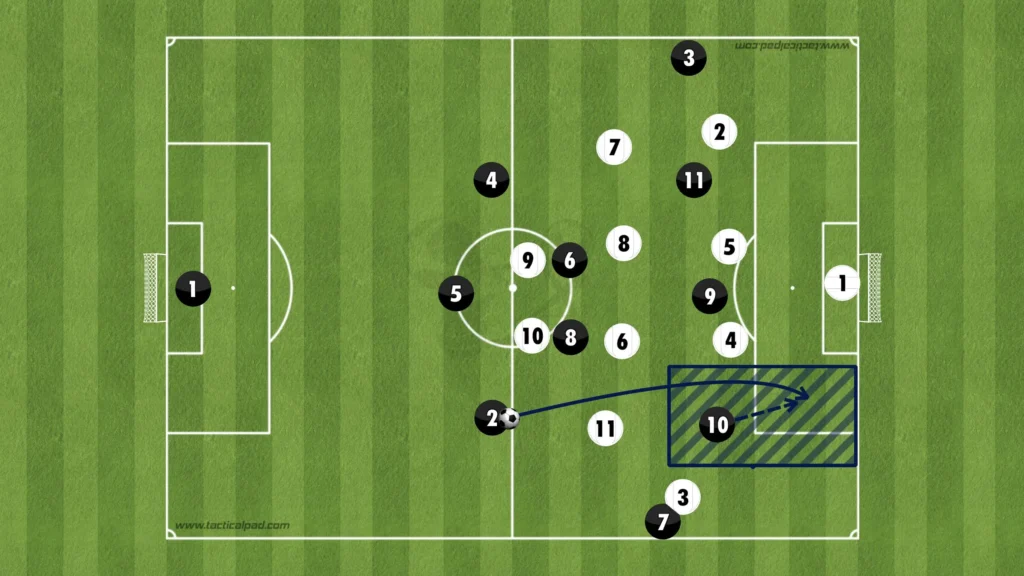
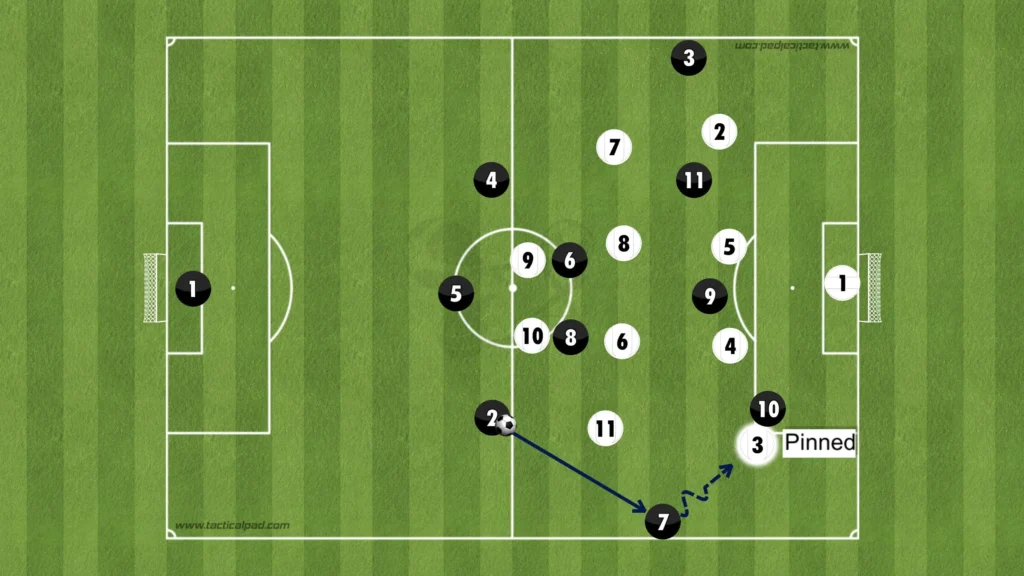
Here, the fullback follows the dropping winger, allowing the attacking midfielder to receive the ball in behind the opposition’s backline.
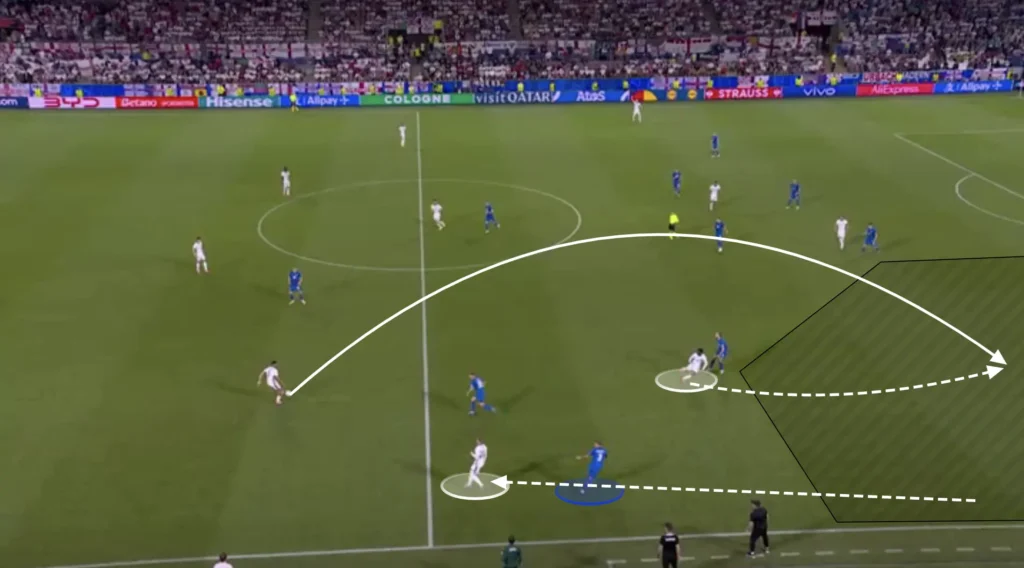
Here, the fullback follows the run from the attacking midfielder, allowing the dropping winger to receive the ball behind the opposition’s midfield.
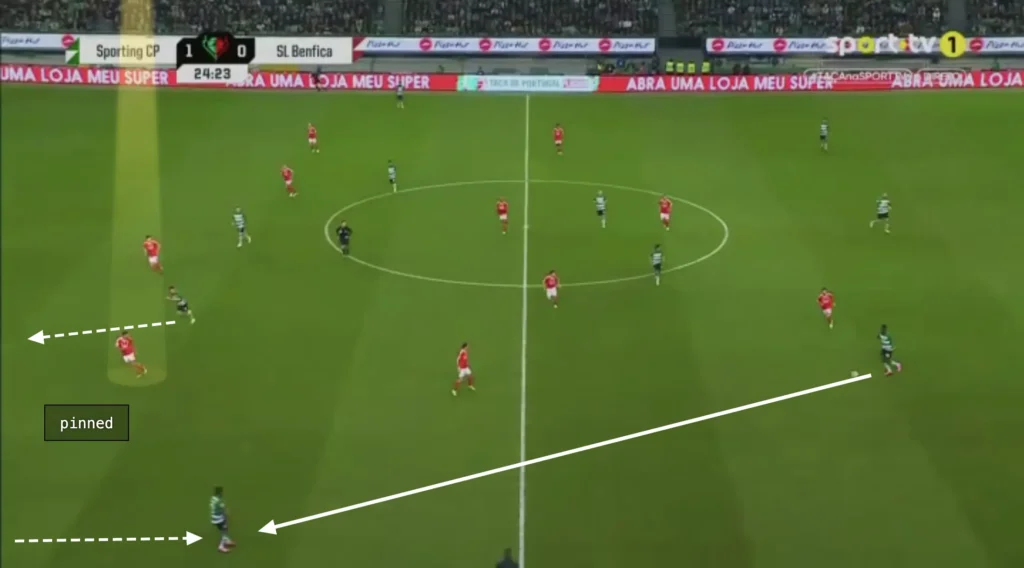
Attacking the Half-Space
When using the 1-3-4-3 formation, a great way to create chances in the final third is to attack the space between the opposition center-back and fullback.
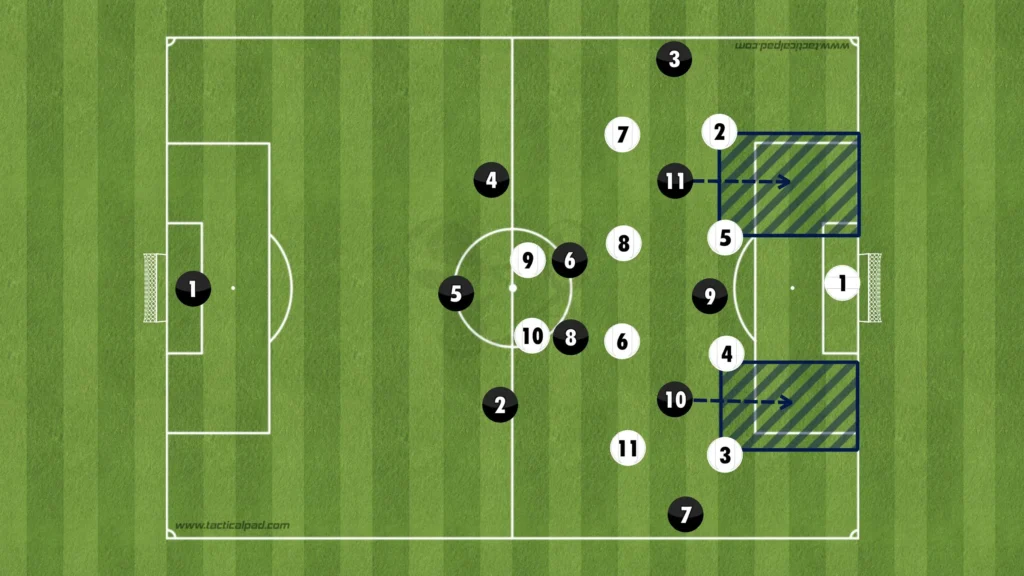
One way to do this is by using an underlap. When the winger receives the ball out wide he will attract the opposition fullback. This opens the space between the fullback and the center-back, which allows the attacking midfielder to make the underlapping run into this space. Here are two images of Man City’s attacking midfielders doing exactly this:
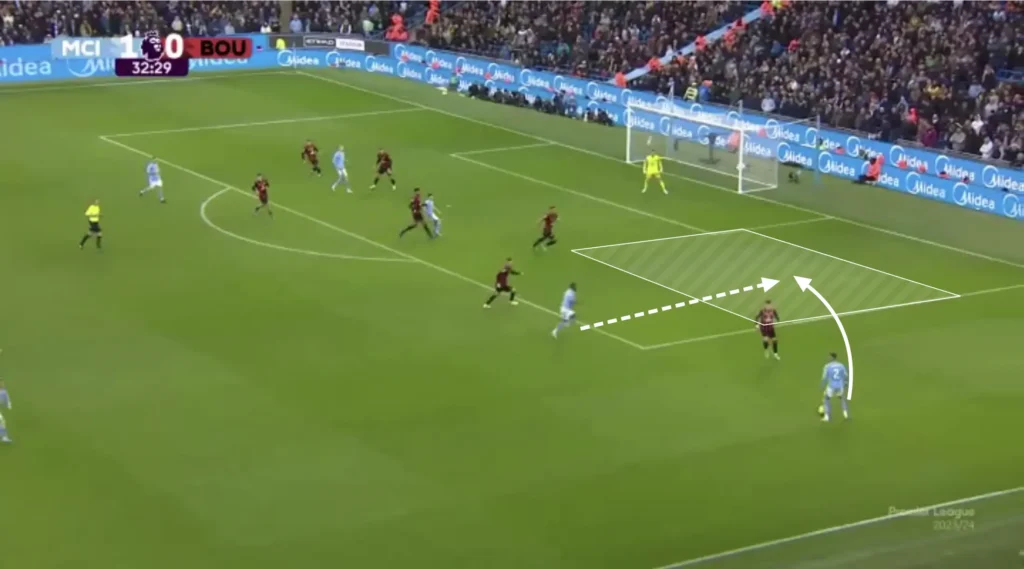
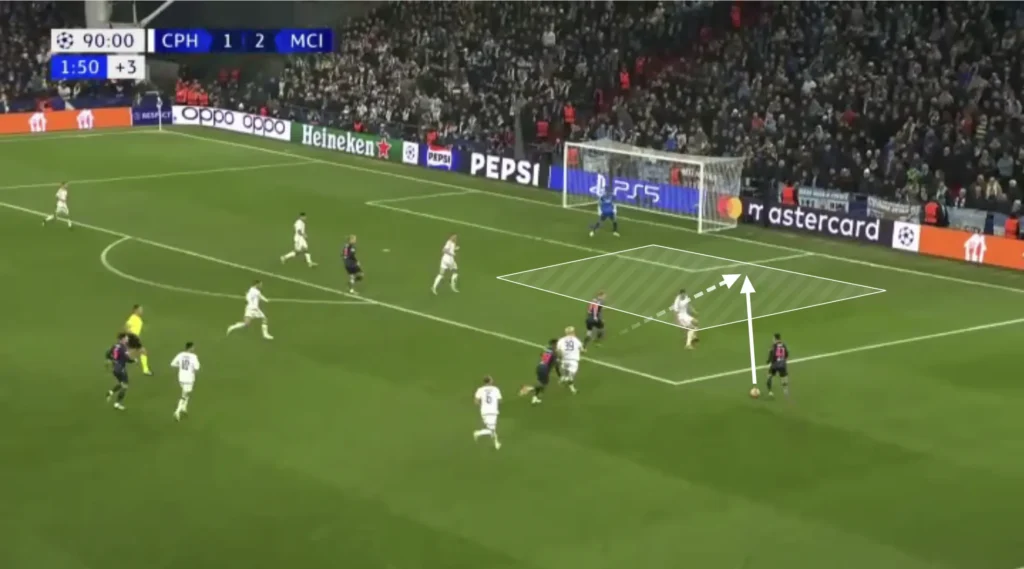
The opposition’s defending midfielder, who is responsible for the underlapping attacking midfielder, often struggles to track this run, which forces the center-back to make a decision. If he goes to track the run, he leaves a massive space in the box for the striker to exploit.
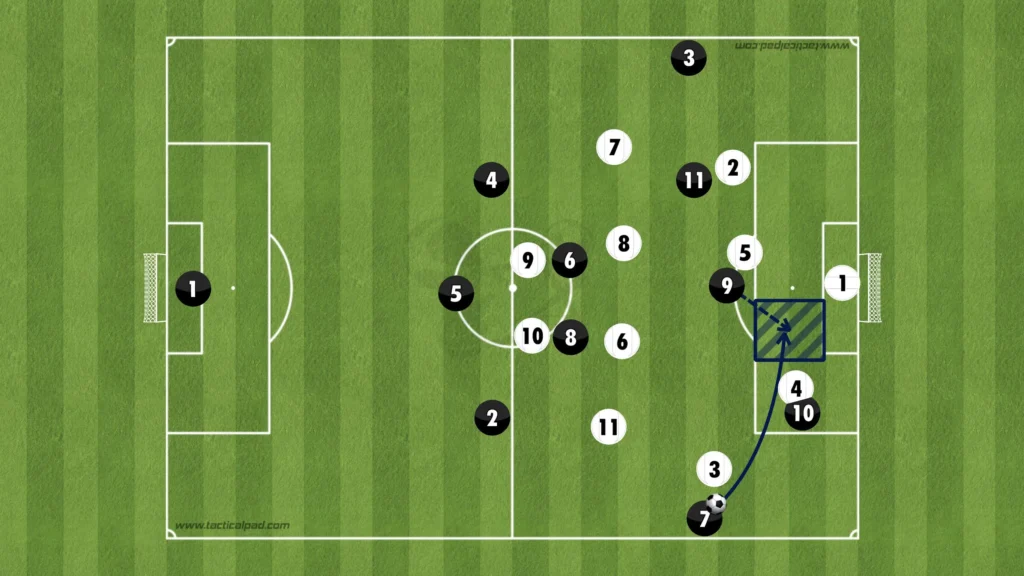
Therefore, many center-backs will stay in the center. This allows the winger to play the ball into the attacking midfielder in the open space.
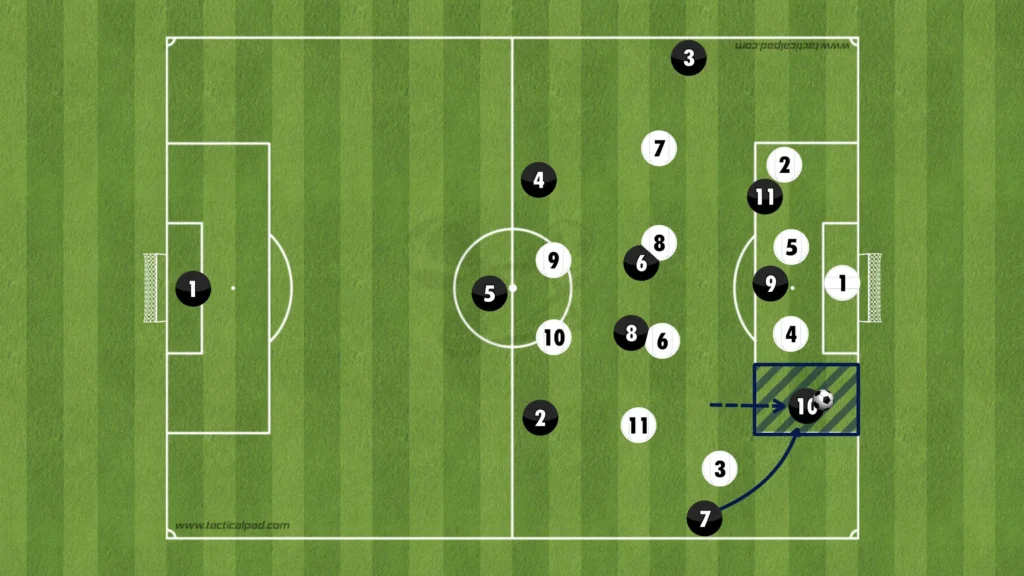
From there, the attacking midfielder will have the space and time to shoot, if he is close enough to the goal, or find an open teammate in the box with a cross.
The winger does not have to play the ball to the underlapping player in the first situation. The run from the attacking midfielder will often drag away an opposition defensive midfielder, which opens the space inside. The winger can take the ball inside and shoot or find a pass to a free player in front of the backline. Here, Bellingham makes an underlapping run that opens the space inside. Foden sees this and takes the ball into the open space.
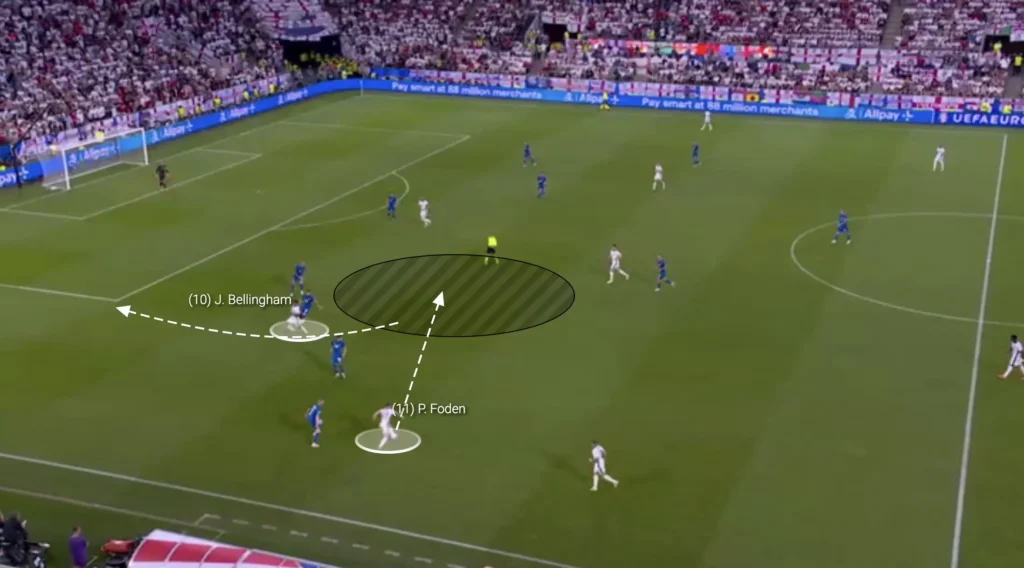
Make the run close to the fullback
An interesting detail about the underlap is that the players usually should make the underlapping run very close to the fullback. The objective of the underlap is to create as big a question as possible for the center-back. If the runner makes the run close to the center-back, the center-back does not have to leave his position much to defend the underlap, which allows him to protect the space in the box and defend the underlap. However, if the runner, like Kevin De Bruyne does in this case, runs close to the fullback, the center-back has to leave his position much more to defend the underlap, which opens the space inside. The question of whether the center-back should stay in his position or track the run, therefore, becomes way bigger if the underlap is made close to the fullback.
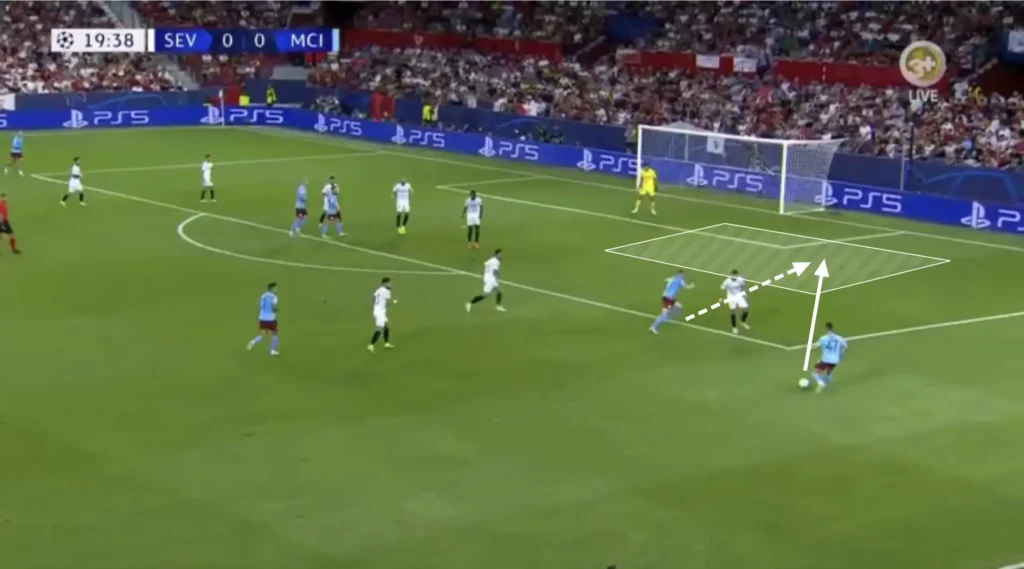
High Pressing in the 1-3-4-3 formation
Pressing high in a 1-3-4-3 formation involves using the front three to apply immediate pressure on the opposition’s defenders, particularly the center-backs and full-backs. The wingbacks in this formation play a crucial role by pushing up to close down wide options, effectively trapping the opponent and forcing them into tight spaces. The three center-backs provide security at the back, allowing the team to commit more players forward in the press without compromising defensive solidity. The midfield duo’s responsibility is to support the press by cutting off passing lanes to the opposition’s central midfielders, making it difficult for the opponent to build out from the back.
High press against a back four
Against a back four, the wingers and striker will be in a numerical disadvantage against the opposition backline, meaning one defender will be open. The three attackers always have to leave the least threatening defender open, usually the defender furthest from the ball. When one of the center-backs gets the ball, the striker could come up and press, the ball-side winger pushes up on the ball-side fullback, and the far-side winger comes up to close the pass to the far-side center-back. Here is how the press would look like against a 1-4-4-2/1-4-2-4 formation:
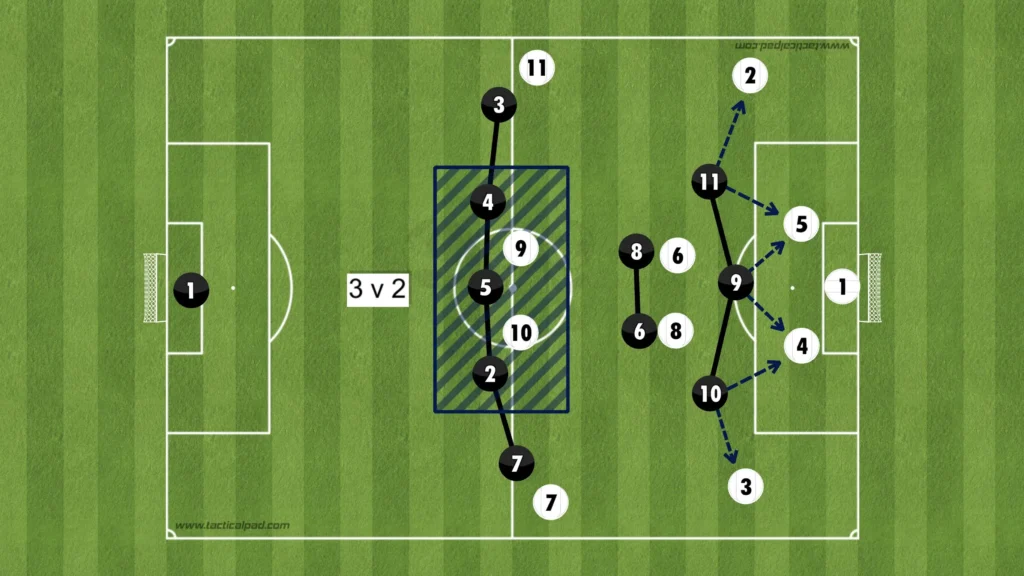
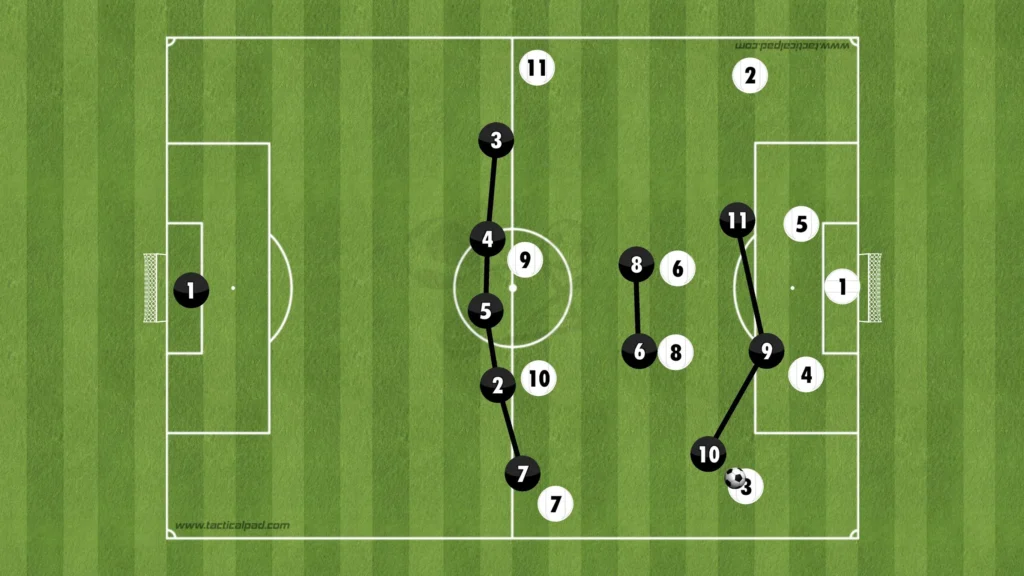
Issues with the switch of play
The most important thing when pressing in a 1-3-4-3 formation is to close the switch of play. If the opposition switches the ball from one fullback to the other, the winger has to run back too far for the team to keep pressing the opposition. Therefore, the striker has to force the ball to one side and then close the back pass to the center-back. The midfielders also have to be very close to their opponents, not allowing them to turn and switch the play.
If the opposition manages to switch the ball to the far-side fullback, perhaps through a long ball, the defending team can still keep pressing the opposition by pushing up the wingback and coming across with the rest of the backline.
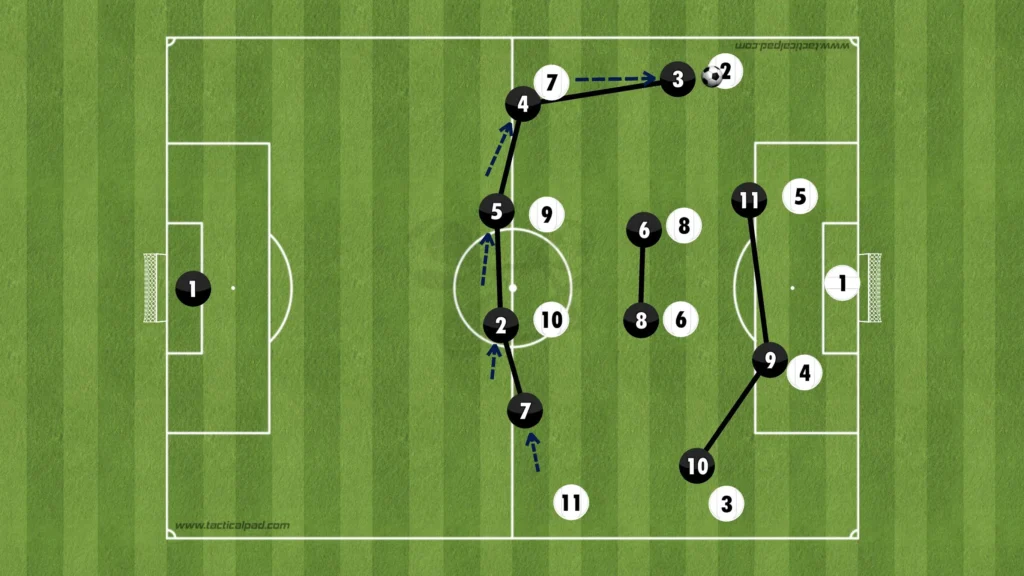
This is, however, only possible if the pass to the opposition far-side fullback is in the air or very slow. If the pass is fast and on the ground, and the fullback can get control of the ball before the defending wingback can push up, the spaces in the backline can be exploited, and goalscoring chances could be created.
High press against a back three
Against a back three, the most natural way to press the opposition will be to go man-to-man. The front three will be responsible for the opposition center-backs, the wingbacks will push up on the opposition wingbacks, and the center-backs and midfielders will be 5v5 in the middle against the opposition midfielders and attackers. Everyone has an opposition player they are responsible for marking, which makes it difficult for the opposition to find open players. Here is what it would look like against a 1-3-4-3 formation:
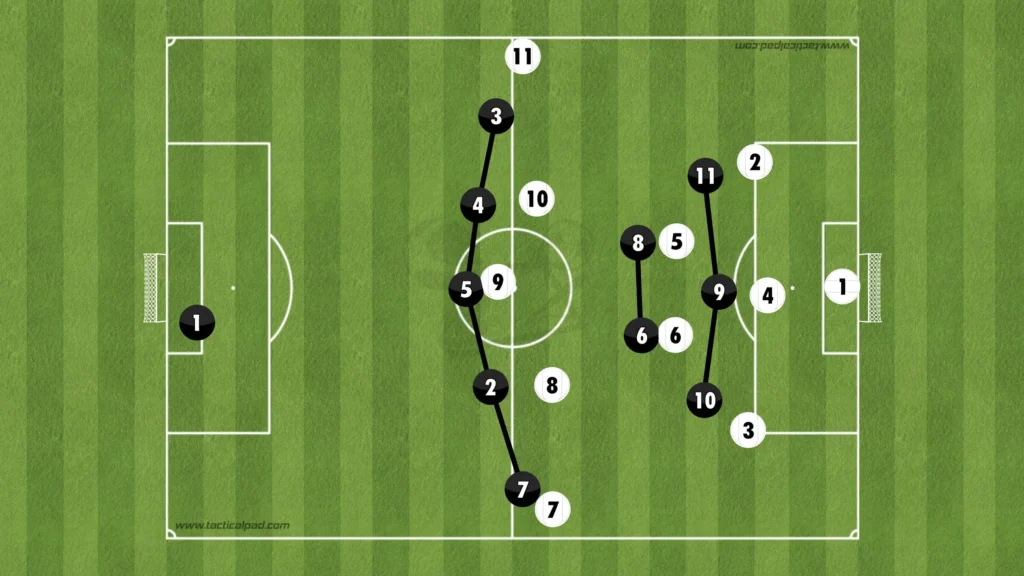
When defending man-to-man, the players must be good at defending 1v1 situations. If they are not and the opposition players win the 1v1 duels to get past their player, another player has to leave their marking, and the entire defensive structure collapses.
In a man-to-man system, it also becomes crucial that the players know when to mark the opponent they are responsible for and when not to. If an opponent, for example, is very far from the ball, the player marking him does not need to be as close to him. He can instead come in and help create numerical superiorities in the center, decreasing the risk of dangerous 1v1 situations. The players will always have an opposition player they are responsible for, however, they should never be closer to them than they need to be.
Mid/Low Press
In the mid/low press, the 1-3-4-3 formation will usually look more like a 1-5-4-1 or a 1-5-2-3 formation. These have different advantages and disadvantages, and which one to use depends on the individual and collective qualities of the players.
1-5-4-1
Defending in a 1-5-4-1 formation emphasizes solidity and compactness, making it particularly effective against teams that rely on wide play or quick transitions. The five defenders, including three center-backs and two wing-backs, create a strong defensive line that can absorb pressure and cover the width of the pitch. The four midfielders in front of the backline provide an additional layer of protection, often pressing the ball and cutting off passing lanes, while also helping to maintain the team’s shape. The lone striker remains higher up the field and usually tries to push the opposition to one side. This formation aims to limit the opposition’s space, forcing them to take risks or attempt crosses, which can be more easily defended with the numbers in the box.
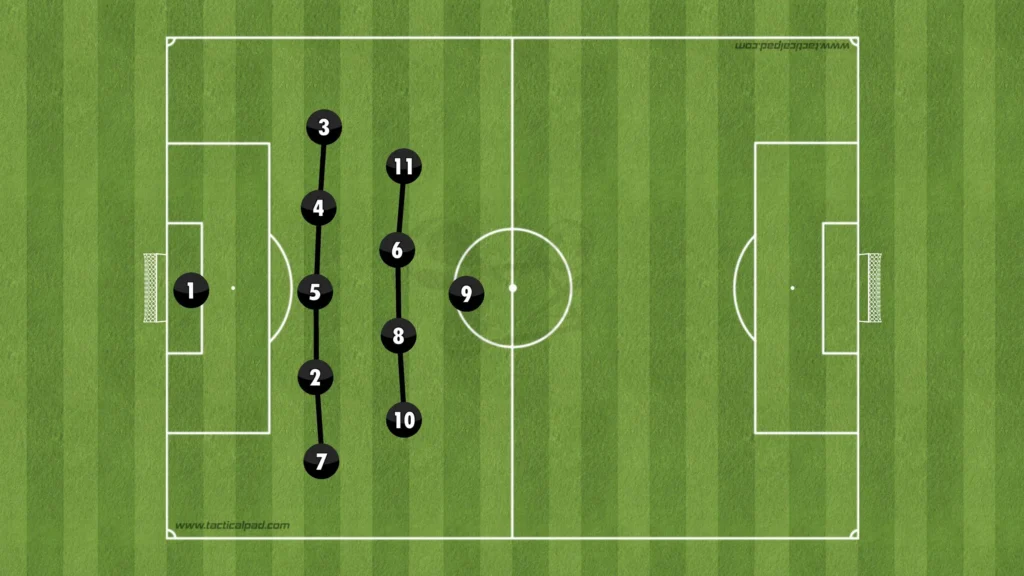
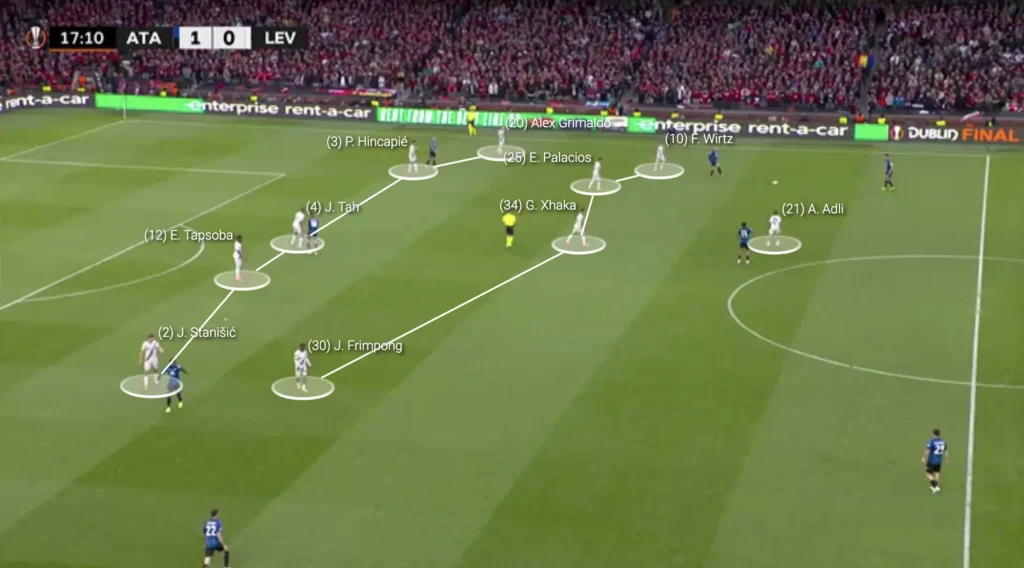
The 1-5-4-1 is ideal for teams looking to prioritize defensive stability. It will, however, be hard to counterattack in this formation, as the lone striker often becomes too isolated in offensive transitions.
How to deal with center-backs advancing
The opposition backline will also have a numerical advantage at the back when you are defending with only one striker. When the striker pushes up to press one of the center-backs, the ball can be played to the other center-back, who can take the ball forward. To stop this center-back from advancing too far, a central midfielder might have to push up. If the central midfielder pushes up, space opens up in the midfield. Therefore, the other midfielders must drop back behind the pushing midfielder to stop the opposition from exploiting this space.
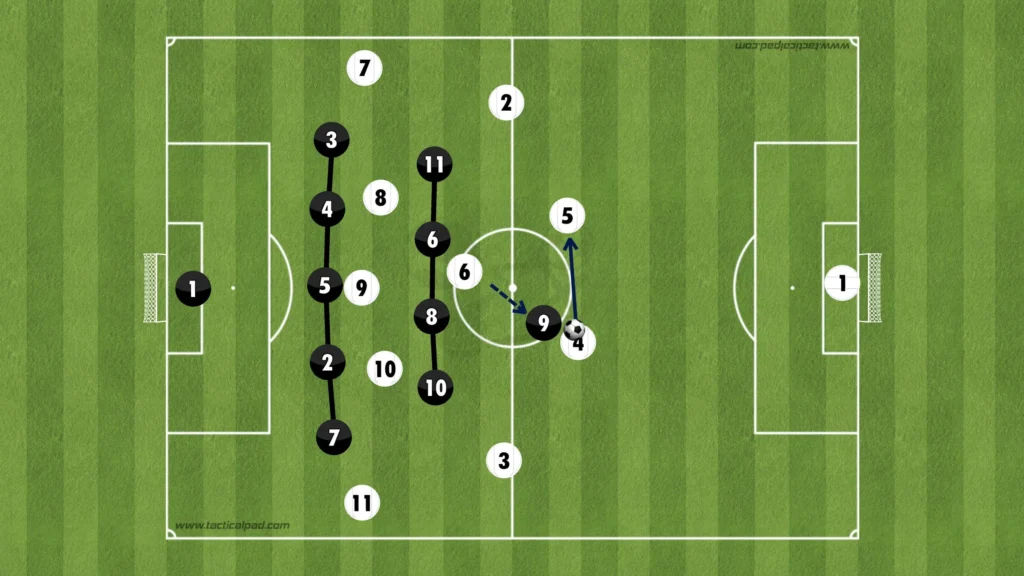
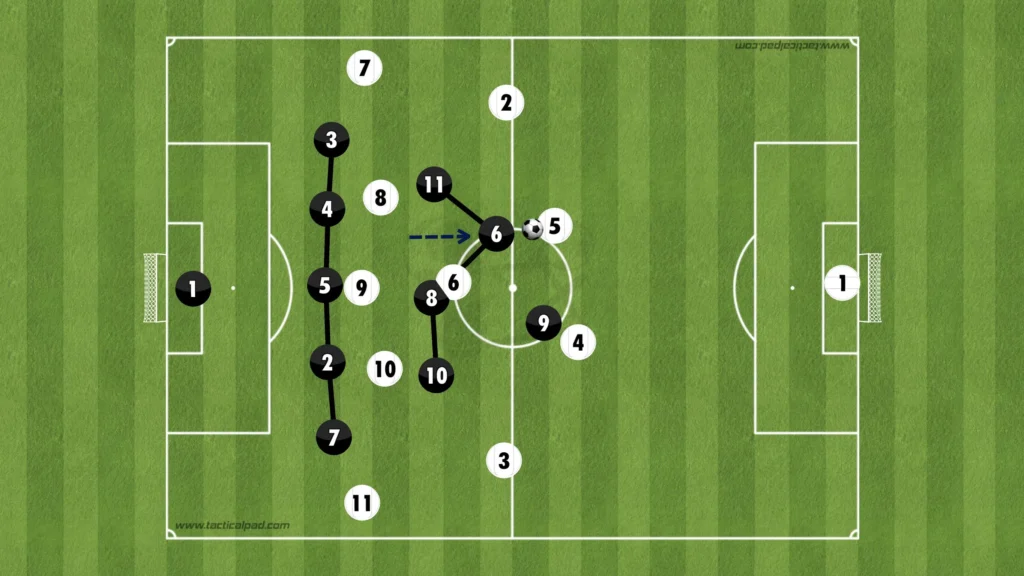
1-5-2-3
Defending in a 1-5-2-3 formation is centered around maintaining a compact forward line that forces the opposition to progress the ball on the flanks. You still have a back five, consisting of three central defenders and two wing-backs, which provides robust coverage across the pitch. This allows the team to effectively manage wide attacks while staying compact in the center. The two central midfielders play a crucial role in shielding the defense, pressing the opposition’s midfielders, and preventing direct passes through the middle. The front three will be more central, allowing the wingers to support the striker in pressing the opposition center-backs.
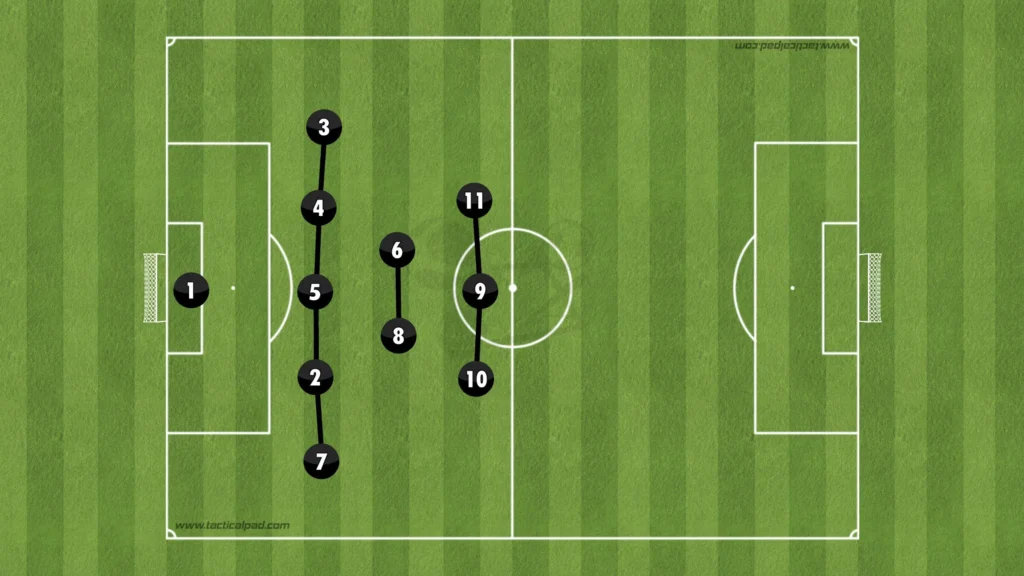
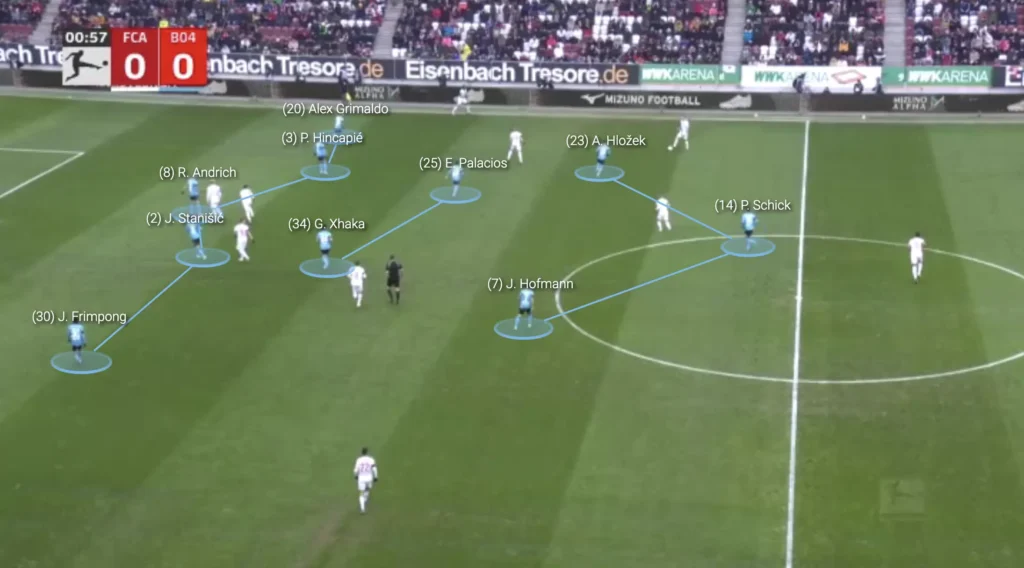
This formation is particularly effective in counterattacking scenarios. The wingers and striker will be central and high up, meaning they could immediately go at the opposition when winning the ball. However, problems could arise when the opposition beats the forward line, as the double pivot often gets outnumbered in the midfield.
Final Thoughts
In conclusion, the 1-3-4-3 formation is a highly adaptable system that offers both defensive solidity and attacking flexibility. By emphasizing numerical superiority in key areas, this formation enables teams to control the midfield, create overloads against opposition defenses, and apply effective high pressing. However, it requires disciplined positioning, strong technical skills, and excellent understanding among players to maximize its potential. Whether used for building up from the back, countering opposition presses, or launching dynamic attacks, the 1-3-4-3 provides a comprehensive approach to modern football tactics, making it a powerful option for teams aiming to dominate both defensively and offensively.
